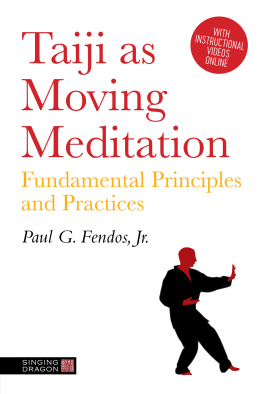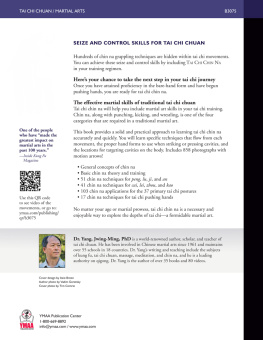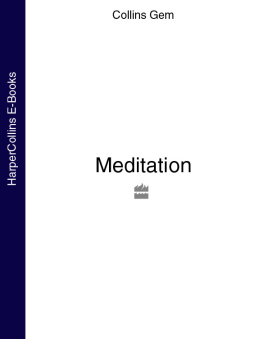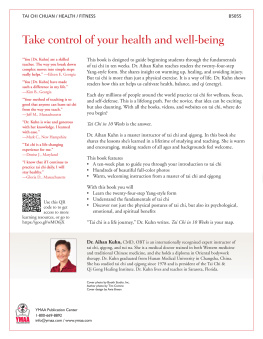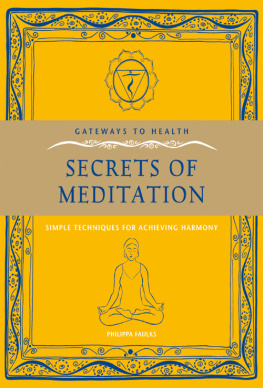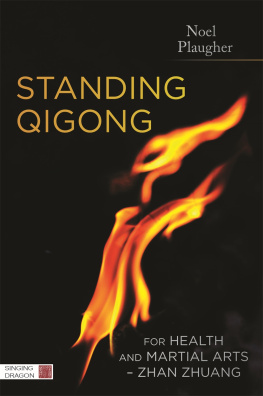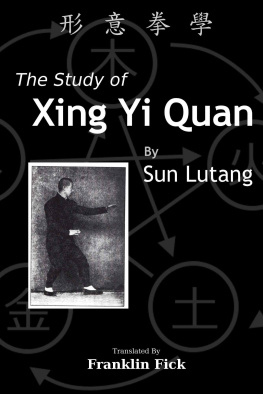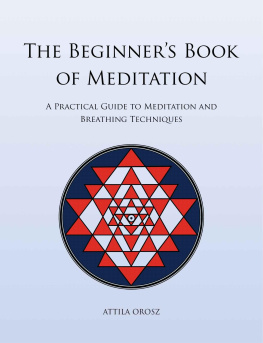
Taiji as
Moving
Meditation
Fundamental Principles
and Practices
Paul G. Fendos, Jr.

Contents
Preface
I have spent the greater part of the last 40-plus years studying East Asia. An important part of that effort has focused on the martial arts, which have become an integral part of my daily life. As I have aged, I have come to appreciate the practice of Taiji, a Chinese soft martial art that offers its practitioners the opportunity to maintain skills and conditioning while also developing what might best be called a greater spiritual awarenessincreased perception of ones surroundings, as well as an inner quiet that opens the door to a new appreciation of life and a greater sense of wellbeing. With China and things Chinese becoming the object of more and closer examination by an increasingly wide range of readersincluding a growing number of people looking for time-tested East Asian forms of exercise and healingnow seems the opportune time to offer this new look at Taiji and its place in the culture of exercise and health.
Taiji really is a unique form of exercise, one not difficult to learn, and one that functions to replace stress with relaxation, anxiety with calm and peace of mind. Described by some as an adjunct to regular medical care that contributes to the prevention and rehabilitation of many conditions associated with both injury and age, Taiji has been shown to enhance aerobic capacity and muscle strength, giving one greater energy and stamina, while improving flexibility, agility, coordination, and balance. It also helps lower blood pressure naturally, promoting greater heart health, and reduces chronic inflammation, ameliorating such conditions as arthritis. It is even said to ease levels of depression. No doubt as a result of all of these things, Taiji and its system of mundane practices and concrete goals is fast overtaking general aerobics, strength training, and stretching and flexibility exercises like Yoga as the activity of choice for many people, including the elderly, for whom it may very well be the future of fitness. One cannot go wrong by studying this art and I wholeheartedly recommend it to all.
In ending, a few words of special thanks. To those who contributed most to my understanding and knowledge of martial artsAnthony DeSardi, Lee Baek-Oon, An Hak-son, and Chin Jong-baek. And for their help in facilitating the publication of this bookJames Cherry (Commissioning Editor), Victoria Peters (Production Manager), and Madeleine Budd (Editorial Assistant), all of Jessica Kingsley Publishers.
Paul G. Fendos, Jr.
September 2018
Accessing Videos
A total of ten videos accompany this book, each given a name that reflects its content. These ten videos, from which all still shots are taken and references to which can be found in the different sections of the book, cover everything from an easy-to-learn warm-up to basic moves and the Forms that they make up. A Taiji as Moving Meditation Read Me First document is also provided to help practitioners of Taiji better understand and utilize these videos.
The videos can be accessed by going to www.jkp.com/voucher. On that webpage create an account using your email address and a password. Then log in to your account and redeem the following voucher code, which will allow you to download the videos: BUEZURE.
Introduction
A long with the Chinese character, Confucius, and the Great Wall, the slow rhythmical form of exercise we know as Taiji has become almost synonymous with China. However, in the United States and numerous other countries little is really widely known about it. In fact, most people are unaware that worldwide upwards of 250 million men and women of all ages have already joined the growing movement to learn Taiji, some as part of a rigorous regime for international tournaments and competitions, but most for the various health benefits it is thought to confer. Even a cursory look at its history and philosophy tells us a lot about Taiji and what it might add to our lives.
The earliest use of the word Taiji can be found in the Book of Changes , the central philosophical work of the Chinese tradition. As most evidence suggests that the Book of Changes probably originated during the 4th3rd centuries B C E , some people have concluded that the beginnings of Taiji may also very well date to that time. However, this is just not the case. Although its origins are indeed ancient, other than the general belief that Taiji originated sometime during the second millennium of the Christian era, there is no real consensus on exactly when it began.
This general lack of consensus is due, in part, to disagreement over who might have been the first to initiate practices that can clearly be associated with Taiji. One common theory asserts that such practices most likely originated with Zhang Sanfeng, a legendary 13th-century Daoist monk. An expert in numerous fighting styles and weapons, he was a practitioner of Internal Boxing, a system of fighting that utilized soft movements to avoid and counter strong attacks. Another theory claims it was created by Chen Wangting (15971644), a general and skilled martial artist who combined his military experience, knowledge of traditional Chinese medicine, and other popular teachings to establish the Chen school of Taiji. Whatever the case, its association with these two men convincingly demonstrates that in its earliest stages Taiji was essentially another form or school of martial arts .
Today numerous styles of Taiji are practiced. The Chen style, characterized by both fast and slow movements as well as short bursts of power, is still quite popular, especially among martial arts enthusiasts. However, both in East Asia and the West it is the Yang style, a Chen-style offshoot established by Yang Luchan (17991872), that is now most likely to be associated with Taiji. With its soft fluid movements and unwavering stances, this style might best be described as the quintessential form of modern Taiji. The Hao-Wu, the Sun, and the Wu styles, all of which can trace their origins to the Chen and Yang schools, are also widely practiced, but often, it seems, to supplement and enhance the study of the Chen or Yang styles.
In addition to these five traditional schools, there is a more recent style, aptly referred to as New Style Taiji, that is growing in popularity. Closest in form to the Yang School, this style really combines elements of multiple schools. It is an important development in the field and a school of practice that anyone wishing to become part of the Taiji movement will no doubt want to learn. Associated with the International Wushu Federation, it provides the best overall systematic approach to studying Taiji in terms of fundamental practices and Forms, while offering a clear framework for helping interested practitioners advance in their study of this art. The Forms introduced in this book are part of the New Style regimen.
The philosophy of Taiji is centered on the concept embodied in its nameusually translated as the Great Absolute. This philosophy assumes a world in which all phenomena in nature can be explained in terms of Qi , the Vital Energy emanating from the Great Absolute, and the two Primary Modes of creation which arise from that Vital Energythe Yin and the Yang . The Yin and Yang are contrasting yet complementary forces, perhaps best understood as representations of a Principle of Opposites on which they are based . Within the context of Taiji as exercise and meditation, all movements can be seen as reflections of this Principle of Opposites. Steps can be seen as advancing or retreating, movements of the limbs as extending or retracting, breathing as exhaling or inhaling, and striking and blocking techniques as being hard or soft. Practiced correctlythat is to say synchronized and in harmony with this Principle of Oppositesone slowly begins to cultivate the Vital Energy that is said to permeate the world, acquiring, in the process, the benefits this energy is thought to bestowvigor, strength, and longevity, but also focus and peace of mind.
Next page
